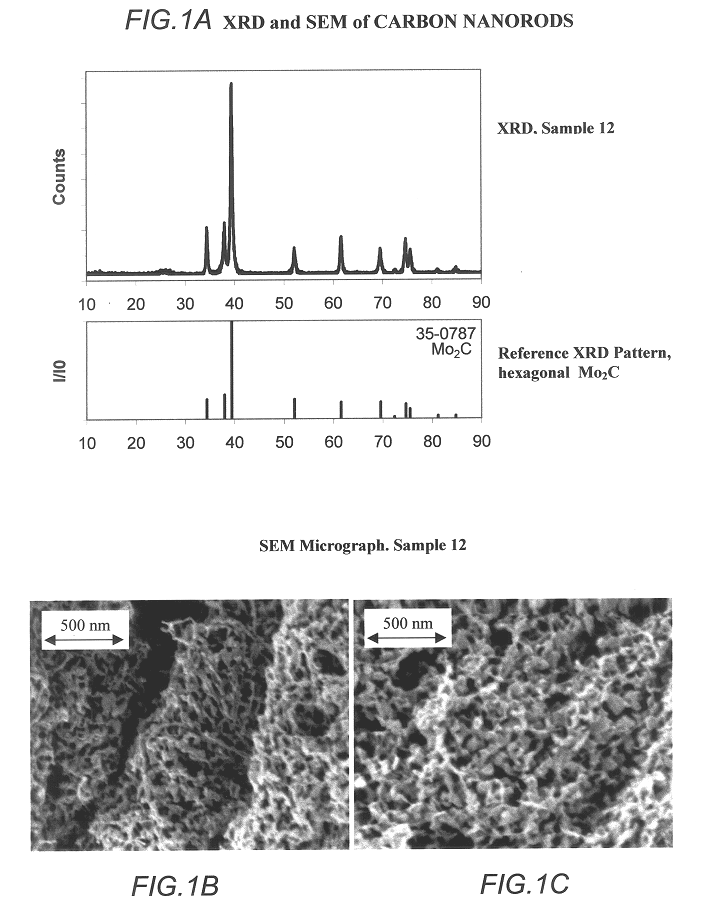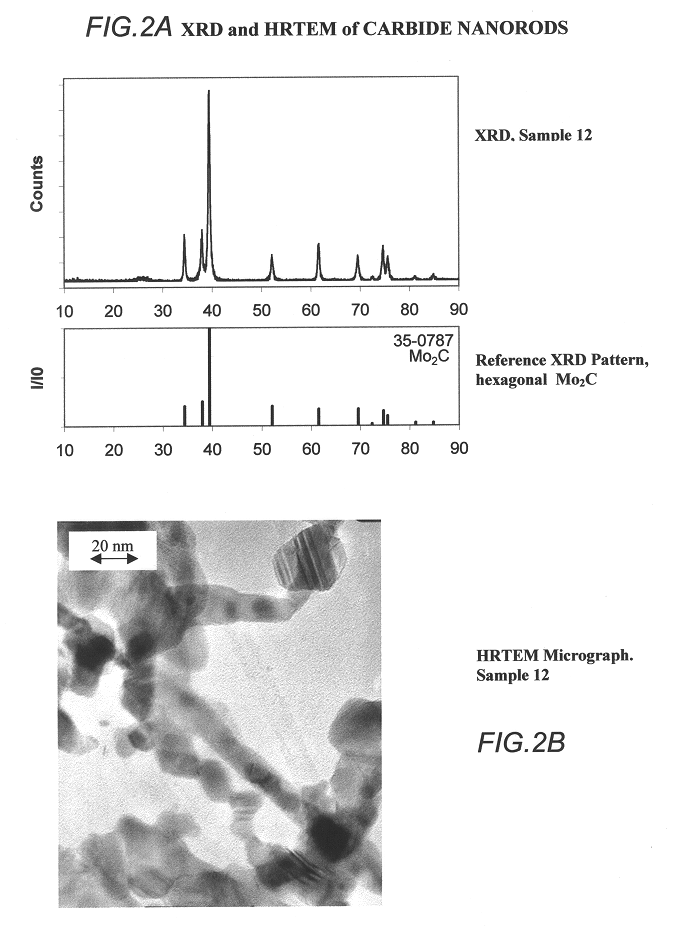Carbide and oxycarbide based compositions, rigid porous structures including the same, methods of making and using the same
a technology of oxycarbide and composition, applied in the direction of hydrocarbon by isomerisation, hydrocarbon/metal-oxide catalyst, hydrocarbon by hydrogenation, etc., can solve the problems of contaminating the product, the cost of separation from the reaction mixture, and the inaccessibility of the pores, so as to facilitate the diffusion of reactants and products and the flow, and the macroporosity of carbon nanotubes
- Summary
- Abstract
- Description
- Claims
- Application Information
AI Technical Summary
Benefits of technology
Problems solved by technology
Method used
Image
Examples
example 1
Preparation of Moybdenum Carbide Precursors by Impregnation of Carbon Nanotube Aggregates with Molybdenum Acetyl Acetonate
Five grams of powder samples of CC aggregates having porosity of 6.5 cc / gm were impregnated by the incipient wetness with 35 cc of an ethanol solution containing the correct amount of MoO.sub.2 (C.sub.5 H.sub.7 O.sub.2)2 or molybdenum acetyl acetonate (herein referred to as Moacac) necessary for the desired C:Mo atom ratio loading. The resulting mixture was dried at 110.degree. C. at full vacuum for 18 hours during which the Mo precursor decomposed to a mixture of molybdenum suboxides, generally designated as MoO.sub.3-x, wherein x is 0 or 1. The sample was set aside for conversion to carbide catalysts by careful calcination under an inert atmosphere as described in Examples 5, 6 or 7 hereinbelow.
example 2
Preparation of Moylbdenum Carbide Precursors by Impregnation of Carbon Nanotube Aggregates with Ammonium Moybdate
A similar procedure as used in Example 1 above was followed, except that the impregnating solutions were aqueous solutions containing the correct amount of ammonium heptamolybdate tetrahydrate or (NH.sub.4).sub.6 Mo.sub.7 O.sub.24.4H.sub.2 O herein referred to as ammonium molybdate necessary for the desired C:Mo atom ratio loading. The resulting mixtures were dried at 225.degree. C. in full vacuum for 18 hours during which the heptamolybdate compound was decomposed to MoO.sub.3. The sample was set aside for conversion to carbide catalysts by careful calcination under an inert atmosphere as more particularly described in Examples 5, 6 and 7 herein.
examples 3
Preparation of Molybdenum Carbide Extrudate Precursors by Impregnation with Molybdenum Acetyl Acetonate or Ammonium Molybdate
CC or CY type aggregates were oxidized with nitric acid as described in U.S. application Ser. No. 08 / 352, 400 filed Dec. 8, 1994 entitled "Functionalized Nanotubes" to form oxidized CC aggregates having an acid titer of about 0.6 mg / g).
Five grams of the oxidized CC type aggregates of carbon nanotubes were well-mixed with either an ethanol solution of Moacac or an aqueous solution of ammonium heptamolybdate tetrahydrate, each solution containing the correct amount of Mo compound necessary for the desired C:Mo loading. The mixing was accomplished by kneading in a Braybender kneader until the paste had a homogeneous consistency. The excess solvent was removed from the kneaded sample by evaporation until a solids content of from about 8 to about 10% by weight was obtained. The material was then extruded by using an pneumatic gun extruder. The extrudates were about...
PUM
| Property | Measurement | Unit |
|---|---|---|
| Length | aaaaa | aaaaa |
| Length | aaaaa | aaaaa |
| Length | aaaaa | aaaaa |
Abstract
Description
Claims
Application Information
 Login to View More
Login to View More - R&D
- Intellectual Property
- Life Sciences
- Materials
- Tech Scout
- Unparalleled Data Quality
- Higher Quality Content
- 60% Fewer Hallucinations
Browse by: Latest US Patents, China's latest patents, Technical Efficacy Thesaurus, Application Domain, Technology Topic, Popular Technical Reports.
© 2025 PatSnap. All rights reserved.Legal|Privacy policy|Modern Slavery Act Transparency Statement|Sitemap|About US| Contact US: help@patsnap.com



